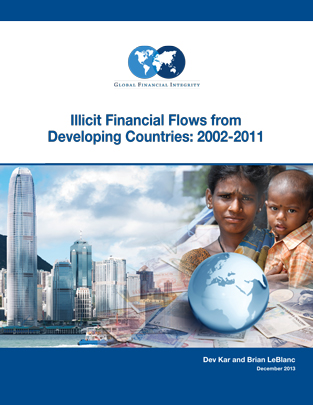Latest estimates show India lost US$343.93bn in illicit outflows from 2002-2011
http://www.gfintegrity.org/report/2013-global-report-illicit-financial-flows-from-developing-countries-2002-2011/
The report finds that from 2002 to 2011, developing countries lost US$5.9 trillion to illicit outflows. The outflows increased at an average inflation-adjusted rate of 10.2% per year over the decade—significantly outpacing GDP growth.
China leads the world over the 10-year period with US$1.08 trillion in illicit outflows. However, 2011 marked the first time that Russia’s illicit outflows exceeded China’s, with a loss of US$191.14 billion against China’s US$151.35 billion. The previous methodology had significantly understated Russia’s illicit outflows, while it overstated China’s illicit outflows.
http://www.gfintegrity.org/report/2013-global-report-illicit-financial-flows-from-developing-countries-2002-2011/
Illicit Financial Flows from Developing Countries: 2002-2011
This December 2013 report from Global Financial Integrity, “Illicit Financial Flows from the Developing World: 2002-2011,” finds that the developing world lost US$5.9 trillion in illicit financial flows from 2002-2011, with illicit outflows alarmingly increasing at an average rate of more than 10 percent per year.
The report is the fourth update of Global Financial Integrity’s groundbreaking report, Illicit Financial Flows from Developing Countries 2002-2006. For the first time, this year’s report incorporates re-exporting data from Hong Kong and uses disaggregated—as opposed to aggregated—bilateral trade data for those countries which report it.
Primary Findings
The developing world lost US$946.7 billion in illicit outflows in 2011, an increase of 13.7% over 2010. The capital outflows stem from crime, corruption, tax evasion, and other illicit activity.
The report finds that from 2002 to 2011, developing countries lost US$5.9 trillion to illicit outflows. The outflows increased at an average inflation-adjusted rate of 10.2% per year over the decade—significantly outpacing GDP growth.
As a percentage of GDP, Sub-Saharan Africa suffered the biggest loss of illicit capital. Illicit outflows from the region averaged 5.7% of GDP annually. Globally, illicit financial outflows averaged 4% of GDP.
China leads the world over the 10-year period with US$1.08 trillion in illicit outflows. However, 2011 marked the first time that Russia’s illicit outflows exceeded China’s, with a loss of US$191.14 billion against China’s US$151.35 billion. The previous methodology had significantly understated Russia’s illicit outflows, while it overstated China’s illicit outflows.
New Methodology
Last year, Global Financial Integrity debuted several important revisions to its HMN (Hot Money Narrow) methodology for calculating illicit financial flows. This report continues to revise GFI’s methodology by making significant changes to how it calculates GER (Gross Excluding Reversals) to estimate trade misinvoicing.
For the first time, this year’s report incorporates re-exporting data from Hong Kong and uses disaggregated—as opposed to aggregated—bilateral trade data for those countries which report it. The authors of this report believe that GFI’s previous methodology—which was accepted by most economists studying trade misinvoicing—resulted in an estimate that potentially overstated illicit outflows from many Asian countries and understated illicit outflows from other countries. Post-revision, the authors believe they have produced the most accurate estimate of global illicit financial outflows produced by GFI to date.
Click here for a more thorough briefing on methodologies used by GFI.
Country Rankings
The Top 25 countries with the highest measured cumulative illicit financial outflows between 2002 and 2011 were:
Rank | Country | Illicit Outflows | Rank | Country | Illicit Outflows |
|---|---|---|---|---|---|
| 1. | China: | US$1.08tn | 14. | Philippines: | US$88.87bn |
| 2. | Russia: | US$880.96bn | 15. | Costa Rica: | US$80.65bn |
| 3. | Mexico: | US$461.86bn | 16. | Belarus: | US$75.09bn |
| 4. | Malaysia: | US$370.38bn | 17. | Qatar: | US$62.82bn2 |
| 5. | India: | US$343.93bn | 18. | Poland: | US$49.39bn |
| 6. | Saudi Arabia: | US$266.43bn | 19. | Serbia: | US$49.37bn |
| 7. | Brazil: | US$192.69bn | 20. | Chile: | US$45.20bn |
| 8. | Indonesia: | US$181.83bn | 21. | Paraguay: | US$40.12bn |
| 9. | Iraq: | US$78.79bn1 | 22. | Venezuela: | US$38.97bn |
| 10. | Nigeria: | US$142.27bn | 23. | Brunei: | US$38.37bn2 |
| 11. | Thailand: | US$140.88bn | 24. | Panama: | US$38.09bn |
| 12. | United Arab Emirates: | US$114.64bn2 | 25. | Turkey: | US$37.28bn |
| 13. | South Africa: | US$100.73bn |
Image may be NSFW.
Clik here to view.![Description: PDF]() Download Full Country Rankings (66 KB)
Download Full Country Rankings (66 KB)
Image may be NSFW.
Clik here to view.![Description: PDF]() Download Full Country Outflow Data (152 KB)
Download Full Country Outflow Data (152 KB)
Clik here to view.
 Download Full Country Rankings (66 KB)
Download Full Country Rankings (66 KB)Image may be NSFW.
Clik here to view.
 Download Full Country Outflow Data (152 KB)
Download Full Country Outflow Data (152 KB)FOOTNOTES
- Data for Iraq was not available in 2002-2006, thus the average illicit outflows of US$15.76 billion reflect only the years 2007-2011. Likewise, the cumulative outflows of US$78.79 billion for Iraq are cumulative outflows for 2007 through 2011 only.
- Illicit financial outflow estimates from the oil exporting nations of Brunei, Qatar, and the United Arab Emirates should be viewed with caution as they could be inflated due to opaque transactions with their nation’s sovereign wealth funds. GFI has flagged these countries in particular as their Net Errors and Omissions are greater than 50% of their Financial Account.
Read Report
Acknowledgements
About the Authors
Dev Kar is Global Financial Integrity’s Chief Economist, having formerly served as a Senior Economist at the International Monetary Fund.
Brian LeBlanc is a Junior Economist at Global Financial Integrity.
Contributions
Raymond Baker, Christine Clough, Clark Gascoigne, and Joshua Simmons and other GFI staff provided helpful comments which are gratefully acknowledged.
Funding
Funding for this report was generously provided by the Ford Foundation and the Financial Transparency Coalition.


